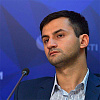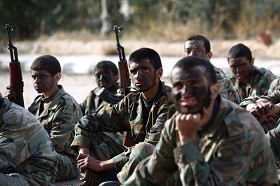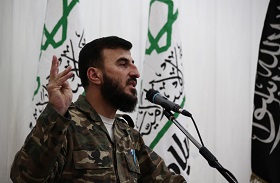As far as groups in the Syrian conflict are concerned, it was Jaysh al-Islam, or the Army of Islam, and not the Islamic State or even Jabhat al-Nusra (al-Qaeda’s Syrian branch) who first officially declared war on Russia, or rather on its military presence in Syria. The New York Times made this news public in October 2015, although with no reference either to the source or the date of such a statement. The news has flooded Russian media but the group is still hardly known in comparison to IS or Jabhat al-Nusra. With Jordan currently making the list of Syrian terrorist organizations, which is vital for rating Syria's key political actors, it is appropriate to trace the inception and growth of Jaysh, the territories under its control, its social base, ideology, capabilities and relations with counterparts.
Jaysh al-Islam is a major Syrian antigovernment organization that emerged from an amalgamation of various cells that were almost fully led by Syrians. Its backbone is Liwa al-Islam or Brigades of Islam led by Zahran Alloush, which operated in the vicinity of Damascus. The group is still very potent, especially in the city of Duma, the stronghold of Jaysh al-Islam, and in Eastern Guta [1]. This happened to be the hotbed of the 2011 protest that ousted government forces and in 2012 brought about a harsh blockade followed by a complete lack of food and medicines. In 2013, Eastern Guta suffered sarin attacks, with no clarity about the culprit and charges flying against both the government and the rebels.
Liwa al-Islam took responsibility for the bombing on July 18, 2012 of the Syrian National Security Service, where government security chiefs were holding a meeting. The attack took the lives of Defense Minister Daowd Rajiha, his deputy Assef Shawkat, the vice-president’s assistant and former defense minister Hassan Turkmani, and Director of National Security Department of BAATH Regional Department Hisham al-Ikhtiyar [2], which brought fame to the organization and virtually paralyzed decision-making in the government armed forces.
On September 24, 2013, the eleven strongest Islamist groups, including several brigades of the Syrian Free Army operating around Damascus and Aleppo, jointly stated their rejection of the National Coalition supported by the West and some regional states as the representative of Syrians in the international arena, as well as the Supreme Military Council, its armed wing, headed by General Salim Idris. As such, Sharia law was recognized as the main source of legislation. As early as September 29-30, at least 50 groups near Damascus closed ranks and took the name of Jaysh al-Islam. On November 22, 2013, a coalition emerged under the dual leadership of Jaysh and Harakat Ahrar al-Sham al-Islamiya and their chiefs Zahran Alloush and Hassan Abbud, who was killed at an Ahrar meeting by a bomb allegedly placed by his rivals from IS. The coalition was titled Al-Jabha al-Islamiya (Islamic Front). These moves have only uncovered the bankruptcy of Western support rendered to the Syrian Free Army which was losing strength and personnel. These individuals were attracted to the Salafi who were more durable and adaptable to hardships as well as to even more radical Jihadist slogans geared towards the establishment of a Sharia-based Islamic state or an Emirate in Syria.
Jaysh al-Islam has been led for a long while by the charismatic Zahran Alloush, for good reason titled sheikh by his associates.
He was born in the city of Duma, 10 kilometers northeast of Damascus, his father Sheikh Abdullah Alloush being a leading Syrian preacher of the Sunni Salafi version. Upon graduating from the Sharia Department of Damascus University, Mr. Alloush went to Saudi Arabia to obtain a master’s degree in Hadith and Islamic studies at the Islamic University of Medina which brings up the best scholars in the field. In 2009, the Palestine Department of the Syrian Military Intelligence, which mostly handles Islamic organizations, arrested Mr. Alloush for storing weapons. However, in 2011 he, alongside another 1,500 Salafi and Jihad-related inmates, was released from the notorious Sednaya prison following the overall amnesty granted by President Bashar Assad. Freedom pushed Mr. Alloush to establish his own antigovernment military organization named Saraya al-Islam (Battalion of Islam) which gradually expanded by subduing other cells into Liwa al-Islam and then into Jaysh al-Islam.
On June 19, 2013, in an interview to Al Jazeera TV channel, Mr. Alloush stated that political figures outside Syria cannot represent Jaysh al-Islam, comments that came several months before a similar joint statement by Syrian antigovernment forces. In the same interview, he rejected any talks with Mr. Assad’s administration: “As for a dialogue with the regime, …this is outright criminal, which means that any sort of a dialogue is tantamount to complicity.”
At the same time, many researchers including Aron Lund who authored “Struggling to Adapt: the Muslim Brotherhood in a New Syria” and is publishing Syria in Crisis, insist that the organization receives funds and weapons from the Gulf monarchies and is close to certain Saudi circles, especially since the father of Mr. Alloush resides in Saudi Arabia. The emergence of Jaysh al-Islam can be clearly seen in the context of the Saudi response to the snowballing radicalization of Syrian society and an attempt to prevent the group’s alliance with such even more extreme entities as the Islamic State and Jabhat al-Nusra.
Relations with Other Syrian Groups
Initially located inside the Syrian Free Army, Liwa al-Islam was one of its most efficient components, while after its separation, it subdued several groups near Damascus and became even more self-sufficient, playing an increasingly important role in the Syrian crisis. In 2012, it joined the Islamic Front for Liberation of Syria which also incorporated the Faruq Battalions (mostly near Homs and the Turkish border), Brigades of Tawheed (Aleppo) and Brigades of Suqur al-Sham (Idleb). However, the consolidation of several groups in late September 2013 brought about the emergence of Jaysh al-Islam which broke with the Islamic Front for Liberation of Syria.
At the same time, changes were taking place in the alliance called the Syrian Islamic Front, which was formed on December 21, 2012 and is based on Ahrar al-Sham or rather Harakat Ahrar al-Sham al-Islamiya, as it was known in those days [3]. Unlike the Syrian Islamic Liberation Front, which used to coordinate its operations with the Supreme Military Council of the Free Syrian Army, the Syrian Islamic Front was free of such obligations as it was deemed ideologically unfit and possessed individual funding channels from Saudi Arabia, Turkey, Qatar, Kuwait and the Muslim Brotherhood.
In fact, it was the emergence of Jaysh al-Islam on September 29 with Saudi support that brought about the structural fissures in the Free Syrian Army and badly damaged its further operations. Nevertheless, government forces failed to exploit the situation because a new broader coalition rose to incorporate groups from the Syrian Islamic Front and Syrian Islamic Liberation Front. On November 23, 2013, Ahrar al-Sham and Jaysh al-Islam, the leaders of these alliances, closed ranks to make the Islamic Front.
Jaysh al-Islam also cooperates with Jabhat al-Nusra, the official representative of al-Qaeda in the lands of Sham, i.e. the territory of historical Levant, whose leader Abu Muhammad al-Julani has repeatedly underlined his adherence to central al-Qaeda headed by Ayman al-Zawahiri and its policy toward a presence in Syria. This strategy is aimed at cooperation with local Islamist groups in order to establish an Islamic state and Sharia in Sham. As a result, Syrian Islamist entities including Jaysh al-Islam avoid fighting against the al-Qaeda branch, since they prioritize toppling Mr. Assad. The latter goal may require joint action from all allied parties, bearing in mind the effectiveness of al-Nusra and combined military successes vis-à-vis the government forces. Mr. Alloush qualifies his relationship with al-Nusra as brotherly, since they diverge only on certain ideological issues that could be settled through discussions and Sharia. In his interview Mr. Alloush also said that he met Abu Mariah al-Qahtani, an al-Nusra leader, and “found actually no differences in their interpretation of the Sharia.” Their friendliness notwithstanding, there have been reports of mass demonstrations demanding better living conditions which were allegedly inspired by al-Nusra in the summer of 2015 in Eastern Guta against Jaysh al-Islam and the United Command that governs the territory.
Jaysh al-Islam is absolutely intransigent toward the Islamic State (IS) which launched energetic operations on Jaysh territories in early 2015. They clashed in the Kalamuna Mountains, where Jaysh unexpectedly cut into the fight against the IS that was opposing al-Nusra, the government forces, the Lebanese army and Hezbollah. According to Mr. Alloush, this action has been taken to prevent the expansion of IS toward Guta and its inroads into the Jaysh-controlled territories. Mr. Alloush labels IS as takfiri, i.e. those who distract Muslims, and hariji or dissenters. In June 2015, Jaysh al-Islam provided the web with a professional video showing captured IS combatants executed by being shot in the backs of their heads. In fact, this was a use of IS techniques, with the executioners sporting orange outfits and the victims dressed in black, whereas the IS prefers the opposite colors.
However, the key adversary of Jaysh al-Islam is the Syrian government army which has blocked Eastern Guta and Duma, with the fighting between them ongoing nonstop and rebels responding to air raids with missile and mortar fire against targets in Damascus. In 2013, Jaysh and Nusra joined in carrying out a massacre, mostly against Alawites in the city of Adra. In recent weeks there have been reports of people in cages, allegedly captured Alawites, being placed on roofs to serve as human shields. Heavy battles are ongoing in Jobar near Damascus, with accusations against Jaysh snowballing in relation to the disappearance of activists and human rights proponents, Razan Zeytoun being the most prominent figure.
Ideology is hardly an asset of Jaysh. In a video, Mr. Alloush mentions the rule of Banu Umayya, a clan of the Umayya Caliphate in the years 661-750. Under Caliph Abd al-Malik in 685-705, Damascus was the center of the Caliphate, with the corrosive feud effectively eliminated by the ruthless commander al-Hajaj. In the same video, Mr. Alloush insists on the non-Islamic and non-Arab origins of Alawites, labeling them as nusairites and placing them in the same category as Iranians who are also deprived of their Muslim roots and recognized as majus, i.e. the magi and fire worshipers, which is the title of Zoroastrians. The video seems to be aimed at both establishing the Sunni Umayya identity and countering the Shiites, whom Mr. Alloush equals with IS and calls rafidites, i.e. rejecters, hinting at the Shiite negation of the holy rule of those seen by them as usurpers of the Caliphate after the death of the Prophet, for he was to be replaced by the first Shiite Imam and the fourth pious Caliph Ali ibn Abu Talib (599-651). Hence, Mr. Alloush opposes IS who are harijites, and Iran and Alawites who are rafidites and magi. This rhetoric notwithstanding, he often leaves the surrounded Guta to attend the opposition forums outside Syria, while his emissaries continue to negotiate with the government and international actors, from what is known from anonymous diplomatic sources. In the past, the group insisted on Sharia law and the Islamic state in Syria, but with popular discontent in its territories on the rise, he publicly wishes “only things that make the Syrians happy.”
Provided with solid organizational structure and financing, Jaysh al-Islam seems more disciplined than the Syrian Free Army which is disintegrating in the procrastinated conflict and radicalized society. It has also chosen Islamist rhetoric from the very start of the conflict and offers simple social services, which attracts many followers by recruiting in Jaysh-controlled lands.
However, the Russian buildup in Syria is drastically changing the situation, with varying scenarios now possible. We may face a number of compromises between the government and the Islamist forces unrelated to the recognized terrorist entities like Jabhat al-Nusra (which appears to be a problem because Nusra is engaged with antigovernment coalitions) and IS. Certain members of Jaysh al-Islam are even known to admit the need for a ceasefire.
Another scenario involves the defeat of the Islamists within an undefined period, with their combatants flowing outright towards the Salafi and Jihad groups of Nusra and IS because Jaysh also employs openly extremist rhetoric.
Finally, the extension of the conflict is likely.
The events to come will hinge on the support the proxies receive from regional and other actors, whose attitudes should be shaped by their domestic politics.
Establishment religion-based organizations like Ahrar ash-Sham and Jaysh al-Islam which are willing to have an Islamic state in Syria, as well as the subsequent emergence of the Islamic Front have mostly prevented the combatants from switching to transnational radical groups like Nusra (despite its officially proclaimed national identity) and IS. However, it is still an unknown whether a future Syria can find room for Jaysh al-Islam which sticks to outward terrorism and Salafi rhetoric.
1. Elizabeth O’Bagy. The Free Syrian Army. MIDDLE EAST SECURITY REPORT 9 / The Institute for the Study of War. Washington. 2013. P.44.
2. Ibid. P.37.
3. Lund, A. Syria’s Salafi insurgents. The rise of The Syrian Islamic Front // UI Occasional papers # 17. Swedish Institute of International affairs. 2013. P. 26.








